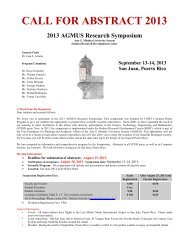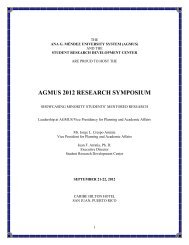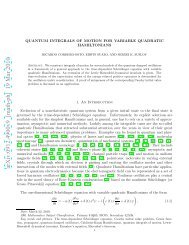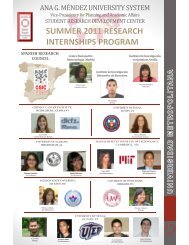WINTER 2008 PRE-COLLEGE RESEARCH SYMPOSIUM - Student ...
WINTER 2008 PRE-COLLEGE RESEARCH SYMPOSIUM - Student ...
WINTER 2008 PRE-COLLEGE RESEARCH SYMPOSIUM - Student ...
You also want an ePaper? Increase the reach of your titles
YUMPU automatically turns print PDFs into web optimized ePapers that Google loves.
COMPUTATIONAL STUDY OF VINYL CYANIDE- C 2 H 3 CN, FOUND IN SGR B2 AND<br />
TMC-1<br />
Natalia González, Bautista de Puerto Nuevo Academy, San Juan, Puerto Rico.<br />
Research Mentors: Dr. Juan F. Arratia, Executive Director, <strong>Student</strong> Research Development<br />
Center, Ana G. Méndez University System, San Juan, Puerto Rico; Dr. José Cernicharo,<br />
Department of Astrophysics, Astrobiology Center, Spanish Research Council (CSIC), Madrid,<br />
Spain.<br />
<strong>Student</strong> Research Mentor: Germán P. Castillo, Universidad Metropolitana, San Juan, Puerto Rico.<br />
The purpose of this research was to learn about the existence of the C2H3CN Vinyl Cyanide<br />
molecule in space and to make a 3D model of this molecule using the software Gaussview. Vinyl<br />
cyanide, also known as acrylonitrile, is a pungent-smelling, colorless liquid often yellow due to<br />
impurities. This molecule was detected in Sagittarius B2 and Taurus Molecular Cloud 1 (TMC-1)<br />
by H. E. Matthews and T. J. Sears. TMC-1 has a temperature of 100K (-173°C) and is one of a<br />
group of clouds of gas and dust, it contains only 1 solar mass of material and is one of the coldest<br />
molecular clouds known. TMC-1 contains some of the most complex interstellar molecules yet<br />
identified due to its stability for many years without forming stars. From the investigation, a<br />
relationship was established between temperature and the energies. The zero point energy<br />
remained constant unaffected by temperature or pressure. The enthalpy and energy showed an<br />
inversely proportional behavior to temperature, and Gibbs free energy behaved directly<br />
proportional to temperature. During this investigation basic chemistry concepts were provided<br />
and it was possible to understand how to correctly model a molecule based on its formula.<br />
COMPUTATIONAL STUDY OF HYDROXYMETHYLIUM - H 2 COH +<br />
MULTIPLE PLACES IN SPACE<br />
FOUND IN<br />
Camila Del Mar Rodríguez, Colegio Puertorriqueño de Niñas, San Juan, Puerto Rico.<br />
Research Mentors: Dr. Juan F. Arratia, Executive Director, <strong>Student</strong> Research Development<br />
Center, Ana G. Méndez University System, San Juan, Puerto Rico; Dr. José Cernicharo,<br />
Department of Astrophysics, Astrobiology Center, Spanish Research Council (CSIC), Madrid,<br />
Spain.<br />
<strong>Student</strong> Research Mentor: Germán P. Castillo, Universidad Metropolitana, San Juan, Puerto Rico.<br />
The purpose of this project was to learn about the existence of the hydroxymethylium H 2 COH +<br />
molecule in space and to model this molecule to identify its energies. The molecule H 2 COH + was<br />
found toward Sgr B2, Orion KL, W51, and possibly in NGC 7538 and DR21 (OH). Sgr B2, one<br />
of the places where the molecule is found, is a massive, dense *HII region (A volume of space<br />
where the hydrogen in the interstellar medium is in an ionized rather than a neutral state) and<br />
molecular cloud complex located near the center of our Galaxy. It is the richest concentration of<br />
molecules in the Milky Way Galaxy. The second objective of this research was to model the<br />
molecule using GaussView software to obtain a 3-D model that was used to make computational<br />
chemistry calculations in order to learn about the molecule energy levels.<br />
30








